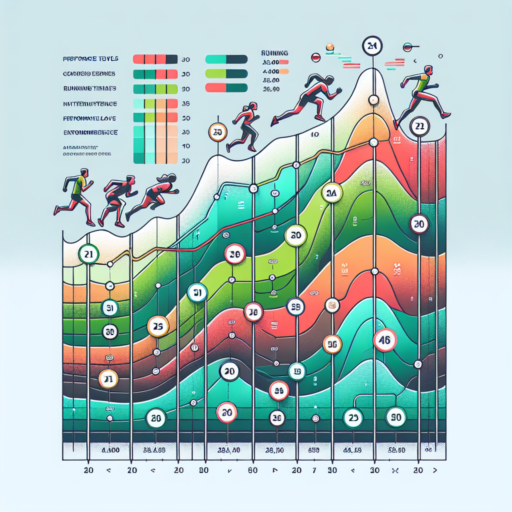What is a good VO2 max for running?
Understanding what constitutes a good VO2 max for running can significantly impact your training effectiveness and performance. VO2 max, or maximal oxygen uptake, is the maximum amount of oxygen your body can utilize during intense or maximal exercise. It is a pivotal measure for assessing an athlete’s aerobic fitness and endurance capabilities.
Factors Influencing VO2 Max
Several factors can influence an individual’s VO2 max, including age, sex, genetics, and training status. For instance, naturally, men tend to have higher VO2 max values than women, and younger individuals typically outscore their older counterparts. However, with targeted training, significant improvements can be made, enhancing a runner’s VO2 max score.
General Benchmarks for Runners
While «good» VO2 max scores can vary widely, general benchmarks can provide guidance. For most recreational runners, a VO2 max between 35 and 45 ml/kg/min is common. Competitive male runners may exhibit values from 70 to 85 ml/kg/min, while elite female runners often range between 60 and 75 ml/kg/min. Notably, world-class endurance athletes can reach VO2 max scores exceeding 85 ml/kg/min, showcasing the heights of human aerobic potential.
Improving your VO2 max involves targeted training designed to stress the cardiovascular system, such as interval training or high-intensity workouts. Incorporating these elements into your training regimen can lead to noticeable improvements in aerobic capacity and running performance.
No se han encontrado productos.
What is a good VO2 max for my age?
Understanding your VO2 max, or the maximum rate at which your body can consume oxygen during exercise, is crucial in assessing your cardiovascular fitness. It varies significantly across different age groups, and what is considered good for one age might not be the same for another.
VO2 Max Norms by Age Group
For men and women, VO2 max tends to peak before the age of 30 and typically decreases by about 1% per year thereafter. However, regular exercise can significantly mitigate this decline. Below are general guidelines for good VO2 max scores based on age and gender:
- 20-29 years: Males – 44-50 ml/kg/min, Females – 36-42 ml/kg/min
- 30-39 years: Males – 42-47 ml/kg/min, Females – 33-37 ml/kg/min
- 40-49 years: Males – 39-43 ml/kg/min, Females – 30-34 ml/kg/min
- 50-59 years: Males – 36-40 ml/kg/min, Females – 27-31 ml/kg/min
- 60+ years: Males – 32-36 ml/kg/min, Females – 24-28 ml/kg/min
It’s important to note that these figures serve as a basic guideline. Various factors, including genetics, training level, and overall health, can influence your VO2 max. Moreover, a “good” VO2 max also depends on your personal fitness goals and the specific requirements of the sports or activities you engage in.
Consistently incorporating aerobic exercises into your routine, no matter your age, can help improve your VO2 max. If you’re interested in measuring your VO2 max, consider consulting with a fitness professional who can administer a test and provide personalized recommendations based on your results.
Is VO2 max 5k pace?
When discussing VO2 max in the context of running, particularly regarding a 5k pace, it’s essential to understand that VO2 max, or maximal oxygen uptake, is the maximum amount of oxygen an individual can utilize during intense exercise. It represents an important measure of aerobic fitness and endurance. However, the relationship between VO2 max and a specific race pace, such as a 5k, is not as straightforward as it may seem. The 5k pace, while heavily influenced by VO2 max, is also determined by several other factors including but not limited to, an athlete’s efficiency, lactate threshold, and overall running economy.
In examining the direct question of «Is VO2 max 5k pace?» it becomes clear that VO2 max is an indicator of an athlete’s potential rather than a precise predictor of their 5k race pace. It’s widely recognized that while a higher VO2 max can indicate a greater potential for aerobic exercise performance, the specific pace an athlete can maintain over a 5k distance is also reliant on their ability to sustain a high percentage of their VO2 max for the duration of the race. This ability is often enhanced through targeted training that improves running economy and increases lactate threshold.
For runners aiming to improve their 5k times, understanding the distinction between VO2 max and 5k pace is crucial. While enhancing VO2 max through aerobic training can aid in improving overall endurance and capacity for exercise, focusing on race-specific workouts is equally important. These workouts may include intervals, tempo runs, and long-distance runs that help improve efficiency and pace at the lactate threshold. Thus, while VO2 max is a significant component of a successful 5k performance, it represents only a portion of the training necessary to achieve optimal 5k race times.
What is the VO2 max zone for running?
Understanding the VO2 max zone for running is crucial for athletes seeking to optimize their performance and endurance. VO2 max, or maximal oxygen uptake, is the highest rate at which your body can consume oxygen during intense exercise. It’s a benchmark for cardiovascular fitness and a predictor of your running potential. The VO2 max zone specifically refers to the intensity at which runners train to improve their aerobic capacity and efficiency.
Training within the correct VO2 max zone can significantly enhance a runner’s speed, endurance, and overall performance. This zone typically falls between 90% to 100% of your maximum heart rate. However, it’s essential to note that this range can vary based on individual fitness levels, training background, and genetic factors. Determining your precise VO2 max zone involves fitness tests conducted by exercise professionals or through advanced wearable technology that estimates these values.
Strategically incorporating workouts that target your VO2 max zone can lead to substantial improvements. These include intervals at your calculated VO2 max pace, hill repeats, and tempo runs. It’s recommended to tackle these high-intensity sessions with caution, ensuring ample recovery time to prevent overtraining and injuries. The balance of training within your VO2 max zone and recovery is key to unlocking your running potential.




